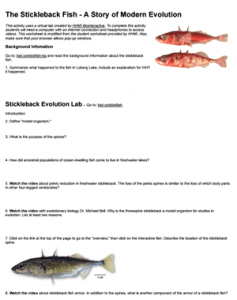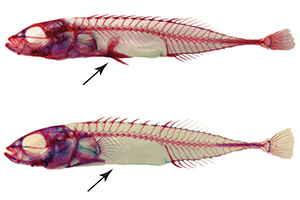
HHMI Biointeractive has thousands of quality resources for teaching evolution. They have several resources, such as films, data labs, and virtual labs on the stickleback fish.
Sticklebacks started out as saltwater fish, and as the glaciers of the last Ice Age receded 10,000 years ago, some of these fish swam inland and became trapped in lakes left behind by the glacial melt1.
Over time, the lake fish came to look quite different from their marine forefathers1. These populations are now natural laboratories for evolutionary studies.
This virtual lab asks students to examine Bear Paw and Frog Lake and compare the types of fish in each. As students progress through the activity, they learn how glacial lakes form. They learn why spines may be an advantage in some types of lakes but not others.
Students also learn about the scientists in the study. How they trap and examine fish and take measurements of spines. The also take data on presence of a complete, reduced, or absent pelvis.

The activity uses real data and images from research this is currently ongoing. The worksheet I have made is modified from the downloadable version on the Stickleback Virtual Lab.
This handout is shorter and designed to be completed in about one class period, with additional time needed for discussion. I have also added analysis questions for advanced classes that ask students to make predictions about other lakes.
The activity uses real data and images from research this is currently ongoing. The worksheet I have made is modified from the downloadable version on the Stickleback Virtual Lab. This handout is shorter and designed to be completed in about one class period, with additional time needed for discussion. I have also added analysis questions for advanced classes that ask students to make predictions about other lakes.
Grade Level: 9-12 | Time Required 1 – 1.5 hours
HS-LS4-4 – Construct an explanation based on evidence for how natural selection leads to adaptation of populations.

